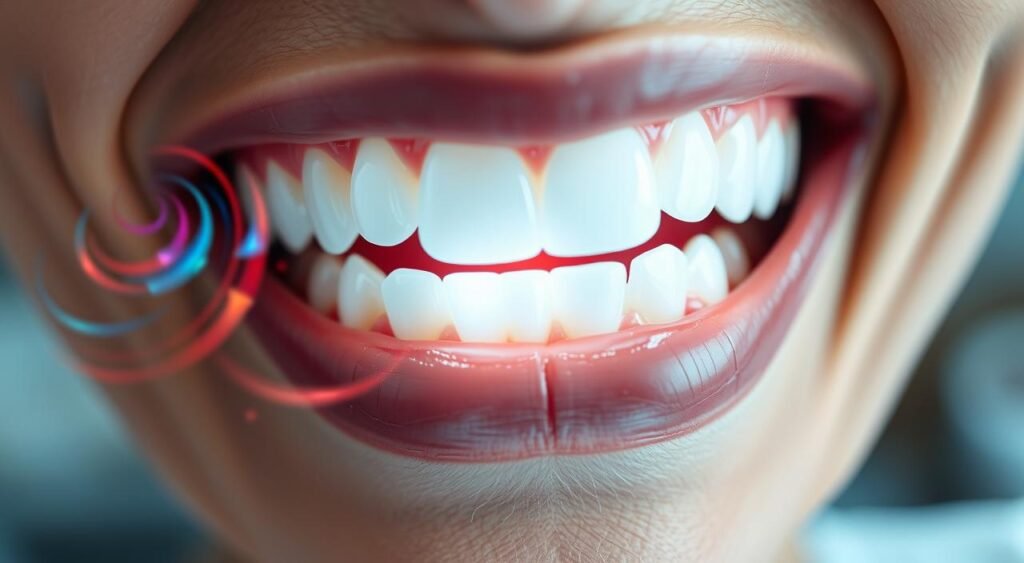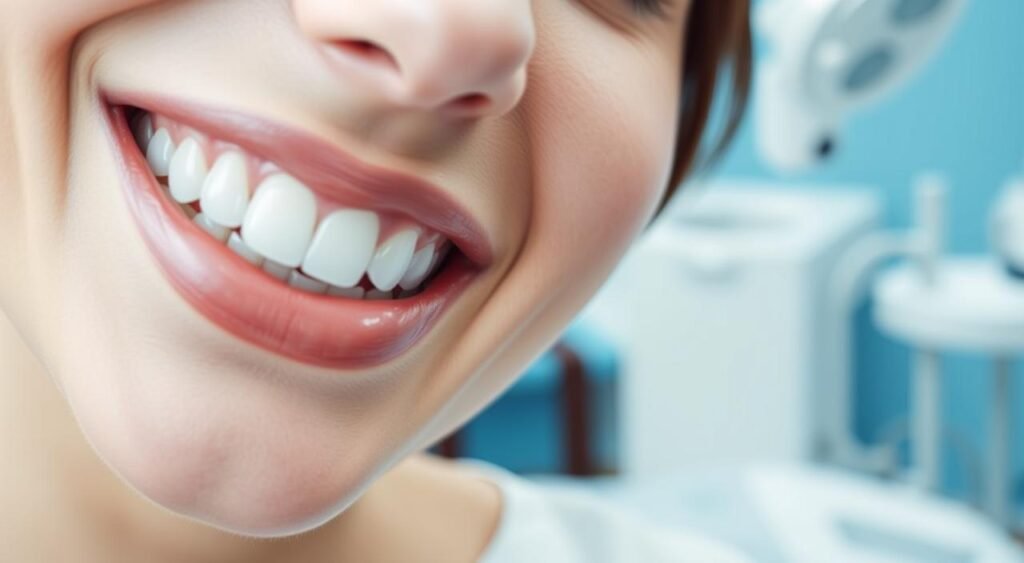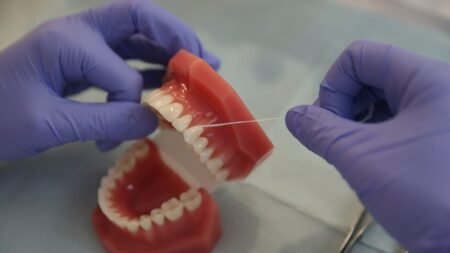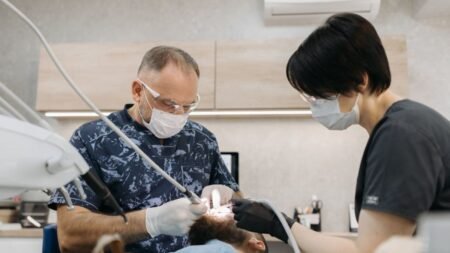Are you thinking about teeth whitening but scared of the pain? Many people worry about this, but today’s whitening methods are safe and gentle. Even though you might feel some sensitivity later, there are ways to make it less uncomfortable.
Dr. Ali Saeghi, a skilled cosmetic dentist, has made many smiles brighter and more confident. He knows how to make teeth whitening safe and pain-free. By learning about the whitening process and taking the right steps, you can get a whiter smile without worrying about pain.
Understanding the Teeth Whitening Process
Teeth whitening is a popular way to get a brighter smile. It uses peroxide-based agents to remove stains. There are two main types: professional in-office treatments and at-home whitening.
Different Types of Whitening Treatments
Professional teeth whitening can brighten teeth up to eight shades in one visit. Dental professionals use laser-activated gels for tough stains. At-home kits, like trays or strips, take longer but are cheaper.
How Bleaching Agents Work
Bleaching agents, like hydrogen peroxide, work by penetrating the enamel. They break down stains, making teeth look brighter. The strength of these agents varies, affecting how fast and well they work.
Professional vs At-Home Whitening
Professional whitening is quicker but pricier. At-home kits are cheaper but take longer. Both can cause sensitivity or gum irritation. Always talk to a dentist before starting any whitening treatment.
Does Teeth Whitening Hurt During Treatment?
Teeth whitening is usually painless. But, some people might feel sensitivity or discomfort after. This happens because the gel makes the enamel more open, exposing the dentin layer with nerves.
The trays used in whitening can also press on teeth, causing sensitivity. Sometimes, the gel might irritate the gums if it touches them.
Studies show that sensitivity can go up, making hot and cold foods hurt. You might also feel pain when biting, chewing, brushing, or flossing after treatment.
But don’t worry, these side effects are usually short-lived. By knowing what might cause discomfort and taking steps to avoid it, you can get a brighter smile without much pain.
| Potential Causes of Discomfort | Solutions to Manage Sensitivity |
|---|---|
| Increased tooth sensitivity Pain while biting, chewing, brushing, or flossing Gum irritation from contact with bleaching gel Cracked teeth or worn enamel Existing dental issues like cavities or gum disease | Use sensitivity toothpaste with potassium nitrate or strontium chloride Take over-the-counter pain relievers like ibuprofen or acetaminophen Rinse with warm salt water to reduce inflammation Avoid extreme temperatures in food and drink Consult a dentist for fluoride gel application or desensitizing treatments |
Knowing what might cause discomfort and finding ways to manage it can make whitening teeth more comfortable. Always talk to your dentist for advice on handling any sensitivity or pain during treatment.

Common Causes of Sensitivity After Whitening
Many people feel sensitivity after teeth whitening. This is mainly because of the peroxide-based bleaching agents used. These agents can make the tooth enamel more open, exposing the dentin layer and its nerves.
Role of Peroxide-Based Bleaching
Bleaching agents like hydrogen peroxide and carbamide peroxide remove stains. But, they can also make the enamel more sensitive. This can cause pain or discomfort during and after the treatment.
Impact on Tooth Enamel
The enamel’s temporary weakening is a big reason for sensitivity after whitening. When it becomes more open, it can expose the dentin layer. This layer has nerves, making teeth more sensitive to hot, cold, and touch.
Duration of Sensitivity
The bad news is that sensitivity can last for 1-2 days after whitening. But, in some cases, it might last longer. This is true if the whitening was too harsh or if you already have sensitive teeth.
To deal with sensitivity, follow your dentist’s advice. Use the products and methods they recommend. With the right care, the side effects of teeth whitening can be managed.
Managing Post-Whitening Discomfort
If you’ve recently had teeth whitening, you might feel some discomfort or sensitivity. This is normal, but there are ways to handle it. You can get back to enjoying your brighter smile.
Avoid eating or drinking hot and cold foods and drinks for 1-2 days after. Extreme temperatures can make sensitivity worse. Stick to lukewarm or room-temperature items. Also, use a desensitizing toothpaste or gel for 48 hours after whitening.
When brushing, be gentle and use a soft-bristled toothbrush. Rinse with lukewarm water, not hot or cold. Fluoride products can help remineralize your teeth and reduce pain. Consider using a fluoride-containing mouthwash or gel.
If the discomfort is too much, try over-the-counter pain medication. Drinking through a straw can also help by reducing contact with your teeth.
Remember, any sensitivity or discomfort should only last a few days. But if it doesn’t go away or gets worse, see your dentist. With proper aftercare, you can enjoy your brighter smile without the discomfort.
Prevention Tips to Minimize Sensitivity
Getting your teeth ready before whitening can really help. Use a desensitizing toothpaste for 10 days before your appointment. This makes your enamel stronger and can lessen pain.
Also, apply a desensitizing gel as your dentist tells you to. This adds extra protection.
Choose professional whitening products with custom trays. This keeps the gel on your teeth, not your gums. Generic trays from stores can cause more pain.
Professional Guidance
Talking to a dentist is key for a safe whitening. They pick the right whitening level for you. They also suggest how to prepare before and care after to avoid pain.
| Tip | Benefit |
|---|---|
| Use desensitizing toothpaste for 10 days before treatment | Strengthens tooth enamel, reducing sensitivity |
| Apply desensitizing gel as directed by your dentist | Provides an extra layer of protection against discomfort |
| Choose professional-grade whitening systems with custom-fitted trays | Prevents gel from contacting gum tissue, minimizing irritation |
| Consult a dentist to determine the right whitening concentration | Ensures a safe and comfortable whitening experience |
Follow these tips to get a brighter smile without too much pain. Always see a professional for the best results. This way, your whitening journey will be safe and comfy.
Safety Measures and Best Practices
Getting a brighter smile is important, but safety comes first. Whether you go for professional teeth whitening or use at-home products, follow safety steps. This ensures a good experience and a healthy smile.
Always talk to a dentist before starting teeth whitening. They check your teeth, give advice, and guide you. This makes sure the treatment fits you and is safe.
- When using at-home teeth whitening products, like gels or strips, read the instructions well. Don’t use them too much, as this can hurt your teeth or make them sensitive.
- For in-office teeth whitening, pick a trusted dentist. They know how to do it right and safely, giving you the best results.
- If your teeth are sensitive, tell your dentist. They might suggest special trays for at-home use. This helps protect your gums and sensitive areas.
Good oral care is key for keeping your teeth whitening looking good. Brush regularly, floss, and see your dentist often. This keeps your teeth and gums healthy and your smile bright.
By following these safety tips, you can get a brighter smile with confidence. You’ll know your teeth are in great shape.
Conclusion
Getting a white smile and brighter smile through teeth whitening can change your life. It boosts your confidence and makes you look better. Even though some sensitivity is normal, today’s treatments are much less painful.
Seeing a dentist and following their advice can make whitening safe and effective. Your dentist can help you pick the best whitening option for you. This way, you can avoid too much sensitivity and keep your white smile looking great for longer.
Good oral care, using products that help with sensitivity, and giving your teeth time to rest between treatments can make whitening easier. Taking care of your teeth and listening to your dentist’s advice helps you get the brighter smile you want. And it keeps your teeth healthy for a long time.
FAQ
Does teeth whitening hurt?
Teeth whitening itself is usually painless. But, some people might feel a bit of sensitivity or discomfort later.
What causes sensitivity after teeth whitening?
Sensitivity after whitening comes from the bleaching agents. These agents can make enamel more open, exposing nerves.
How long does teeth whitening sensitivity last?
Sensitivity usually goes away in 1-2 days. But, using whitening products too much can cause longer-lasting issues.
How can I manage discomfort after teeth whitening?
To ease discomfort, avoid hot and cold foods for a day or two. Use a toothpaste or gel for sensitivity, brush softly, and take pain meds if needed.
How can I minimize teeth whitening sensitivity?
To reduce sensitivity, use a toothpaste for sensitivity before whitening. Apply desensitizing gel as told, and pick professional whitening systems with custom trays.
Is teeth whitening safe?
Teeth whitening is safe if you talk to a dentist first. Follow the instructions and don’t overdo it. Choose trusted dentists for in-office treatments.








